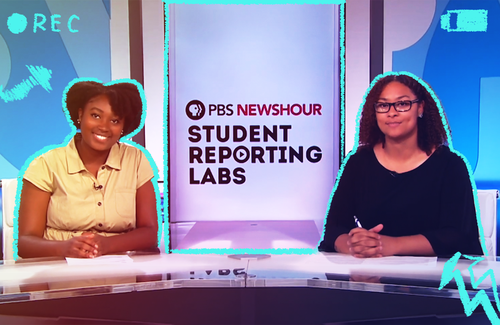
How does news get from the front lines to your feed? Let’s take a look behind the curtain...
Students will gain an understanding of what constitutes broadcast news and how it’s produced. They will use this knowledge to work backwards, investigating and critically analyzing news stories they’ve recently encountered. Click on the Activities Tab to complete the lesson.
What does broadcast journalism look like in today’s complicated digital media landscape?
Students will be able to discuss the historical role of news and media outlets as well as the structure of broadcast news organizations.
This lesson can be used as an introductory media literacy lesson in journalism, social studies, history or other classes.
Understanding the history of broadcast news and the structure of news outlets is critical to media literacy.
How people and communities debate important issues is informed by the media individuals consume and their understanding of accuracy, fairness, and trust. This lesson is one part of a media literacy curriculum that helps young people become savvy news consumers.
Journalism is the activity of gathering, assessing, creating, and presenting news and information.
Non-fiction video or audio communication about topics of public interest disseminated through broadcast or digital methods including tv, radio, streaming, and social media.
Free from mistake or error. Coverage of topics and facts in appropriate detail.
Journalists should strive for accuracy and truth in reporting, and not slant a story so a reader draws the reporter’s desired conclusion.
Complex equations that collect data and monitor users’ behavior to put content in their feeds that they’re likely to engage with.
Civics teaches the principles—such as adherence to the social contract, consent of the governed, limited government, legitimate authority, federalism, and separation of powers—that are meant to guide official institutions such as legislatures, courts, and government agencies. (NCSS D2.Civ.7.9-12 - D2.Civ.10.9-12)
Determine the kinds of sources that will be helpful in answering compelling and supporting questions, taking into consideration multiple points of view represented in the sources, the types of sources available, and the potential uses of the sources. (NCSS D1.5.9-12)
Students recognize the responsibilities and opportunities for positively contributing to their digital communities. (ISTE)
Students leverage technology to take an active role in choosing, achieving and demonstrating competency in their learning goals, informed by the learning sciences. (ISTE)
Students use a variety of technologies within a design process to identify and solve problems by creating new, useful or imaginative solutions. (ISTE)
Explain how a question reflects an enduring issue in the field and explain points of agreement and disagreement experts have about interpretations and applications of disciplinary concepts and ideas associated with a compelling question. (NCSS D1.1.9-12 - D1.2.9-12)
Students communicate clearly and express themselves creatively for a variety of purposes using the platforms, tools, styles, formats and digital media appropriate to their goals. (ISTE)
Historical understanding requires recognizing this multiplicity of points of view in the past, which makes it important to seek out a range of sources on any historical question rather than simply use those that are easiest to find. It also requires recognizing that perspectives change over time, so that historical understanding requires developing a sense of empathy with people in the past whose perspectives might be very different from those of today. (NCSS D2.His.4.9-12 - D2.His.8.9-12)
Journalism
Video Production
Media Literacy
Digital Literacy/Citizenship
Broadcast News
Lessons
Beginner
Intermediate
Advanced
Projector
Online Worksheet
Internet
Notebook
50 Minutes
Lead a class discussion to define what “broadcast news” means in today’s world.
Suggested definition: Non-fiction video or audio communication about topics of public interest disseminated through broadcast or digital methods including tv, radio, streaming, the Internet and social media.
Allow students to review (before or during class) a brief history of American journalism
Use the PBS NewsHour Website: Journalism In Action to explore journalism’s role in American history and society.
Provide or have students find and select two video news stories - at least one of which has been produced by a news organization, not an individual - that they’ve encountered in the past 48 hours. This works best if students can use a phone or computer to access their own social media feeds. If they need help finding stories, suggest they open up TikTok or Youtube and see if they can spot any content about current events:
Ask students to work backwards and investigate:
Give students access to the following resources outlining roles on a news team, types of news items, and broadcast news business models to aid their investigation: Broadcast roles, types and business models WORKSHEET
Now, continue finding the answers to the three questions above with these guidelines:
QUICK DISCUSSION:
What is an algorithm? Social media platforms are run by algorithms, complex equations that collect data and monitor users’ behavior to put content in their feeds that they’re likely to engage with. TikTok’s “For You Page”, Instagram’s “Discover Page”, and YouTube’s “Recommended Videos” all use algorithms to predict what content a user is most likely to engage with the longest.
Why? Social media platforms are expensive to operate but “free” to use, meaning they must rely on advertisers, political campaigns, and content creators paying them for access to specific audiences they’ve identified using algorithms. What kind of news posts do you think might be targeted towards you?
Ask students: How has this exercise helped you understand the way you find news in your daily life?
Ask students: Why is it important to understand the differences in business models for broadcast news?